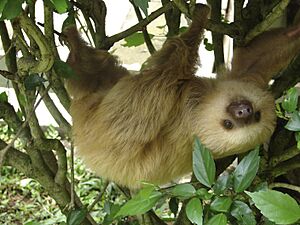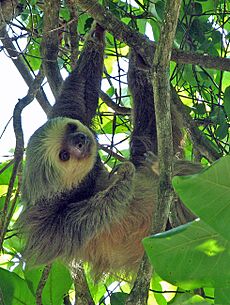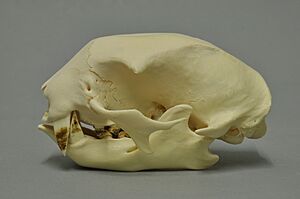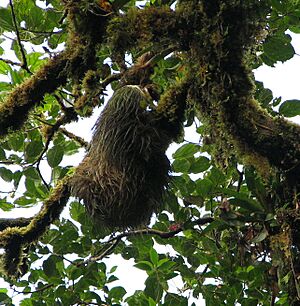Hoffmann's two-toed sloth facts for kids
Quick facts for kids Hoffmann's two-toed sloth |
|
|---|---|
 |
|
| Conservation status | |
| Scientific classification | |
| Genus: |
Choloepus
|
| Species: |
hoffmanni
|
 |
|
| Hoffmann's two-toed sloth range | |
The Hoffmann's two-toed sloth (Choloepus hoffmanni) is a fascinating animal found in the forests of Central America and South America. It's also sometimes called the northern two-toed sloth. These sloths are mostly active at night and live high up in the trees. You can find them in both old and new rainforests and deciduous forests. Its common name honors a German scientist named Karl Hoffmann.
Contents
About Hoffmann's Two-Toed Sloth
The Hoffmann's two-toed sloth is a sturdy animal with shaggy fur. It moves very slowly and carefully. Its front feet have two long, curved claws, while its back feet have three claws.
You can tell it apart from three-toed sloths by a few things. Hoffmann's sloths have a longer snout and no hair on the bottom of their feet. They are also generally bigger. Their wrists have special features that help them move slowly but acrobatically through the trees.
It looks a lot like the Linnaeus's two-toed sloth. The main differences are tiny details in their bones. For example, the Hoffmann's sloth usually has three small holes in a certain part of its skull, while the Linnaeus's sloth has only two.
Adult sloths are about 54 to 72 centimeters (21 to 28 inches) long, not counting their tiny tails. They weigh between 2.1 and 9 kilograms (4.6 to 20 pounds). Their claws can be 5 to 6.5 centimeters (2 to 2.6 inches) long. Female sloths are often a bit larger than males. Their fur is tan or light brown, but it often looks green because tiny algae grow in it!
Where Sloths Live and Their Home
Hoffmann's two-toed sloths live in tropical forests. They can be found from sea level up to 3,300 meters (10,800 feet) high. They live in the tree canopy in two separate areas. One group lives from eastern Honduras down to western Ecuador. The other group lives in eastern Peru, western Brazil, and northern Bolivia. Scientists think these two groups separated about 7 million years ago.
Two-toed sloths spend most of their time hanging upside down in the trees. They love to relax in branches that are tangled together high up in the treetops. They only come down to the ground to go to the bathroom. They also come down if they need to find a new tree to live in or look for new food.
Types of Hoffmann's Two-Toed Sloths
There are five recognized types, or subspecies, of Hoffmann's two-toed sloth:
- C. h. hoffmanni – Found in Honduras, Nicaragua, Costa Rica, and Panama
- C. h. agustinus – Found in Venezuela, western Colombia, and northern Ecuador
- C. h. capitalis – Found in western Ecuador
- C. h. juruanus – Found in Brazil, Bolivia, and far eastern Peru
- C. h. pallescens – Found in Peru
Sloth Behavior and Daily Life
Two-toed sloths spend most of their lives in trees. They might travel on the ground if they need to move to a new tree. In some places, Hoffmann's two-toed sloths are almost always active at night. They move slowly through the treetops for about eight hours each night. During the day, they mostly sleep, often tangled in vines. They move very slowly, usually around 0.14 meters per second (0.3 miles per hour). But they can move up to 50% faster if they get excited!
Sloths are usually found alone in the wild. It's rare to see two sloths in the same tree, unless it's a mother with her baby.
The name "sloth" means "lazy," but their slow movements are actually a clever way to survive. They eat a diet of leaves, which doesn't give them much energy. Sloths have a very low metabolism, about half that of other mammals their size. This helps them save energy.
Sloths have very poor eyesight and hearing. They use their strong senses of touch and smell to find food. They often wobble their heads a lot. Another funny thing about sloths is that they sometimes spit when they open their mouths. Saliva can build up on their lower lip, which looks quite comical!
Sloths hang from tree branches using their huge, hook-like claws. This clinging is a natural reflex. Even after they die, sloths are sometimes found still hanging from trees. They do almost everything upside down: eating, sleeping, mating, and giving birth. They usually come down to the ground to go to the bathroom, which they do about once every three to eight days. They also come down to change trees or to mate. While on the ground, they can walk on their palms and soles.
Scientists have studied why sloths come down to the ground to poop. One idea is that it helps fertilize the trees they live in. Another idea is that it helps them communicate with other sloths using smells. Some scientists also think it helps them pick up tiny nutrients on their claws. A newer idea suggests it's just a behavior passed down from their ancestors, and there hasn't been a strong reason for them to stop.
Sloths have many predators, like jaguars, cougars, ocelots, harpy eagles, margays, and anacondas. If a sloth feels threatened, it can use its big claws to slash or bite with its teeth. But a sloth's best defense is to avoid being seen. Their slow movements and algae-covered fur make them hard for predators to spot. Their homes high in the trees are also out of reach for many bigger predators.
Their long, rough fur also protects them from sun and rain. Unlike other mammals, a sloth's fur grows from its belly towards its back. This helps rainwater slide off while the sloth is hanging upside down.
Hoffmann's two-toed sloths live in different types of trees. They seem to prefer trees with lots of vines and direct sunlight. They usually have a home area of about 2 to 4 hectares (5 to 10 acres). They might spend most of their lives moving between only about 25 trees.
Life Cycle and Reproduction

A female sloth is pregnant for a long time, between 355 and 377 days. She gives birth to one baby. The birth can happen either on the ground or while she is hanging upside down. Newborn sloths weigh about 340 to 454 grams (0.75 to 1 pound). They are born with long claws and can immediately cling to their mother's belly.
Baby sloths start eating solid food when they are about 15 to 27 days old. They are fully weaned (stop drinking milk) by 9 weeks. While adult sloths are usually quiet, young sloths make loud bleating sounds if they get separated from their mothers.
In zoos, sloths have been seen giving birth while hanging upside down. The mother tries to pull the baby between her back legs onto her stomach. Other sloths sometimes hang below the mother and baby to protect the newborn from falling.
Hoffmann's two-toed sloths become ready to have their own babies when they are two to four years old. They have been known to live for up to 43 years in zoos!
Two-toed sloths can mate all year round. However, mating often happens during the rainy season, and births usually occur in the dry season. The female carries the baby for about 11.5 months. Sloths do not usually have one partner for life. When a female is ready to mate, she makes a loud scream that attracts males. If several males show up, they might fight. After mating, the male usually leaves. The female sloth takes care of the baby alone until it is independent. For the first 6 to 9 months, the mother carries and nurtures her baby until it can live on its own.
Sloth Diet and Eating Habits
Most of a two-toed sloth's diet is made up of tree leaves. They also eat buds, tender twigs, young plant shoots, fruits, and flowers. They use their lips to tear off their food. They chew with their peg-like teeth, which have no enamel and keep growing throughout their lives. Sloths have also been seen licking mineral licks, which give them important nutrients.
Scientists believe that two-toed sloths cannot make vitamin D in their skin from sunlight. They get this important vitamin from their diet instead.
Even though they are not true ruminants (like cows), sloths have stomachs with three chambers. The first two chambers hold special bacteria that help them digest the tough cellulose in their leafy diet. The third chamber is like the stomach of most other mammals. It can take a sloth up to a month to fully digest a meal! Up to two-thirds of a sloth's weight can be the leaves in its digestive system.
Sloth Adaptations
Sloths are known for being heterothermic. This means their body temperature can change. Their body temperature ranges from 86 to 93 degrees Fahrenheit (30 to 34 degrees Celsius). This is quite cool compared to other mammals. Having these lower temperatures helps sloths save energy.
A sloth's fur is specially designed to grow algae. The algae grow inside their hair shafts. This green color helps the sloths blend in with the trees, making them excellent at camouflage. Their hair also grows in a unique way: it parts along their stomach and flows from their belly to their back. This is very useful when sloths are hanging upside down, as it allows rainwater to run off easily.
Conservation Status
The destruction of their habitat is likely causing the number of wild Hoffmann's two-toed sloths to decrease. However, we don't have much reliable information on exactly how many sloths are left in the wild. Sloths and humans usually don't interact much in their natural homes.
Images for kids








